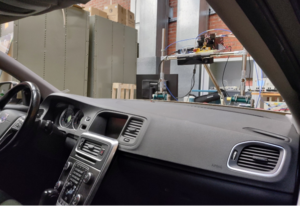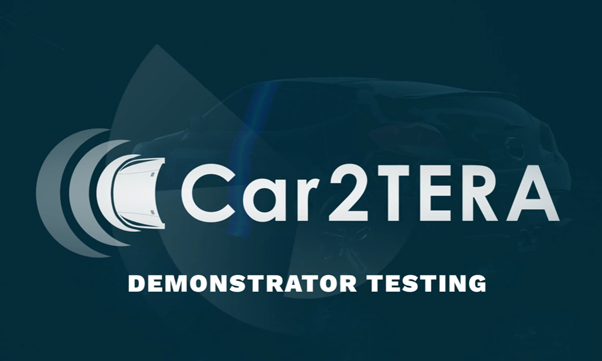In the last couple of months, the Car2TERA in-cabin radar sensor prototype has been brought up and gone through initial testing in the Microwave Electronics Lab at Chalmers University of Technology in Gothenburg, Sweden. After showing capabilities of sub-10 cm ranging accuracy and sensitivity to micro-motions, such as the ones generated when a human is breathing, it was deemed ready for integration with the rest of the in-cabin radar demonstrator system which was developed in parallel at Veoneer’s site in Vårgårda, Sweden. In all, the demonstrator system includes the radar prototype, a radar-mounting jig and, of course, an actual car and its cabin.
The integration work was conducted at Chalmer’s premises and initial demonstrator testing was performed at the end of March this year.
 |
 |
| View of the in-cabin radar sensor prototype with a non-configurable antenna from KTH and the radar-mounting jig. The jig is attached to the hood of the car using suction cups and the metal frame can be tilted and its height adjusted so that the radar looking-angle can be configured. Also, below the radar is a Kinect time-of-flight camera which is the reference sensor system. | View of the radar from the front passenger seat. Notice that the car wind shield has been removed.
|
Testing efforts focused on two main features envisioned for the Car2TERA in-cabin radar concept. One is radar imaging of car occupants, which, for example, aims to infer the driver attentiveness via the driver’s head tilt or to provide information of the occupants’ body pose to safety systems for minimizing the damage in a crash scenario. The other feature is detecting vital signs through micro-motions, which can enable life-saving functionality in post-car crash scenarios or alert the driver if they were to forget pets or children in the car on a hot and sunny day, which could lead to severe and even life-threatening consequences.
Data collection efforts for initial testing were successful and concluded on the 24th of March. In these efforts, participants from KTH Institute of Technology joined in and helped with integrating the fully MEMS-configurable Car2TERA antenna prototype. Due to KTH’s aid combined with preparatory efforts made from Veoneer’s and Chalmer’s side, the testing was quick and effective and resulted in a satisfying collaboration.
Results from the data collection efforts will be reported internally at the end of March 2023, and the analysis will be valuable input for making eventual finishing touches and tweaks to the in-cabin radar demonstrator system before the anticipated final demonstration in June 2023.
For more insights in the process of adding the different elements of the demonstrator view our Video on behind the scenes.
